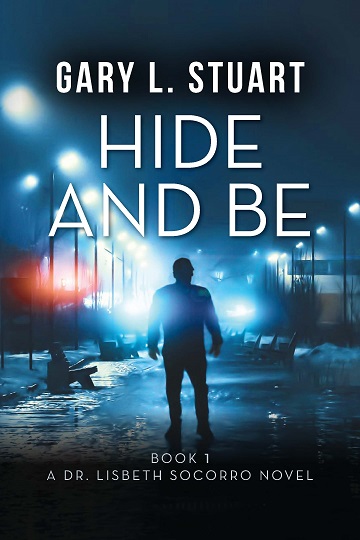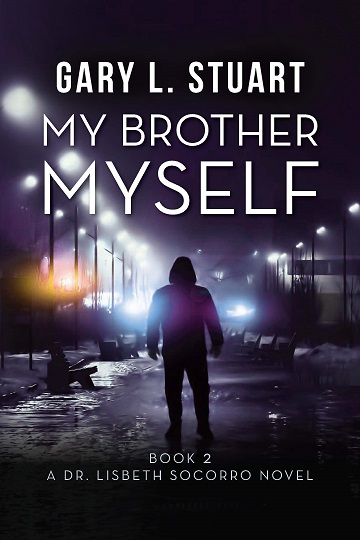Courtrooms are often disguised as theaters and lawyers as actors. But at its core, jury trials are full of stories, wins, uplifts, losses, heart breaks and sometimes, sheer terror. These two books are a lifetime composite of what I learned trying big cases in five states.
Gary L. Stewart – 7 February, 2024
The Back Flap
Hide and Be:
You look exactly like your twin brother. Exactly. You think like him, for him, with him, cannot live without him. Cannot. Don’t want to. Don’t want to. Other kids play Hide & Seek. But you and he play Hide & Be. Your parents died when you were two. The foster parents were sometimes nice and sometimes awful. They could never tell you apart because one of you would hide; the other would just be. Be bad. Be blamed. Be good. Get the Jesus Strap. Get the ice cream cone. There were always eyes on you, then him. Wondering which one you were. There were always voices in your head, his. They can’t judge you because you could always be him, or you. You did not need friends because you are his and he is yours. You learn you don’t need anyone else; they can’t see you, just him. Or are they looking at him, not you? If one of you dies, the other will be. You.
My Brother, Myself:
We are who we say we are. You think you see me-you don’t. You see us without knowing which of us you see. Your photographs, polygraphs, fingerprints, DNA hints, and courtroom theatrics don’t say who we are. We are who we say we are! You are his brother, your twin. You see me but not him now, don’t you? You are like us, identical twins, but you don’t love your brother like I do mine. He is myself, and I am him. Today is your birthday, his too. Why aren’t you with him? Don’t lie to us. We know why. You can live with him but not without him. Too late to choose. We are your redemption. You have a price to pay today. On your birthday. His too. Boo who. We are who we are!
About the book
What is the book about?
In Book One, Hide and Be, the childhood trauma experienced by identical twins results in a game they play to confuse the world and allow one to hide, or to be the other. When the boys become adults, the game is innocent but protective in ways only the twins know. In Book Two, My Brother, Myself, the game and the symbiotic lives they lead reveals a much darker reality in which the death of one brother generates a sense of rage and a dissociative crisis so deep that the survivor twin suffers a much deeper and darker emotional wound.
This book expands the core issue in MZ twinness and the horrific realities of emotional wounding in childhood. It expands those cruel events beyond mere wounds by exploring another widely recognized reality as children become adults and abnormal conduct appears. DID is an emotional wound caused by deep, often horrific trauma. It is terrible to experience, and far worse than most people know. The trauma wound itself is not the most dangerous. It’s what’s behind the wound that astounds and defiles—the lie—the conclusion reached by the child or young adult through flawed logic. Caught in a vulnerable state, they, or at least one of them rationalize the painful experience by falsely concluding within themselves that the fault somehow lies within. That happened to Arty and Marty, the book’s identical twin protagonists. In Hide and Be Martin and Arthur live troubled, but peaceful lives. Martin dies. Arthurs becomes his brother. In My Brother, Myself the survivor twin rarely knows which life he is leading, his or his brothers. This leads to serial murders and baffling FBI, prosecutors, psychiatrist interventions, and judicial twists.
When did you start writing the book?
I wrote the first draft in 2005. Even I knew it was chock full of undeveloped characters, a wandering plot line, no narrative arc, and lots of lawyerly discourse that bored everyone, including me.
How long did it take you to write it?
I rewrote it in 2009, 2015, 2018, and finally in 2022-2023.
Where did you get the idea from?
I was a trial lawyer for 32 years and taught trial advocacy at the national level for ten years. Courtrooms are often disguised as theaters and lawyers as actors. But at its core, jury trials are full of stories, wins, uplifts, losses, heart breaks and sometimes, sheer terror. These two books are a lifetime composite of what I learned trying big cases in five states.
Were there any parts of the book where you struggled?
Yes, motivation for the lay characters—the twins—their employer—their girl friends, and inexplicable connections between the law and reality.
What came easily?
Drama in the court room. Discourse with expert witnesses, especially psychiatrists. Creating realistic lawyers out of whole cloth.
Are your characters entirely fictitious or have you borrowed from real world people you know?
All of my characters are pure fiction. But the lawyers, cops, judges, witnesses all bear some traits and habits of people I worked with, for, in front of, or against in my years as a trial lawyer.
We all know how important it is for writers to read. Are there any particular authors that have influenced how you write and, if so, how have they influenced you?
Robert Service, Irving Stone, John Nichols, Ivan Doig, David Baldacci, A.J. Finn, Wally Lamb, and Stephen King. They told stories based on enormous struggles, fantastic wins and losses, and believable characters. Most important, they were not shy about word count rf page length.
Do you have a target reader?
Educated adults with a wide range of interests in what they read. Readers who like complicated plots with inexplicable twists and unexpected turns in the story.
About Writing
Do you have a writing process? If so can you please describe it?
I don’t much like horror but Stephen King is a master writing teacher. His thesis is tension. To create and maintain tension, the writer cannot know in advance how the story will be told or even what the story actually is. That makes me a “panster.” I do not plot and write from the seat of my pants. My characters talk to me. I create scenes they telepath to me.
Do you outline? If so, do you do so extensively or just chapter headings and a couple of sentences?
I write longform nonfiction based on extensive research, outlining, and plotting. But fiction only works for me if I let the book inform me, page by page.
Do you edit as you go or wait until you’ve finished?
I edit every page 15 or 20 times. I edit as I write. I stop and read whenever the mood strikes me.
Did you hire a professional editor?
Yes, of course. I’m a lousy editor. I hire great editors, including developmental editors as well as copy and line editors.
Do you listen to music while you write? If yes, what gets the fingers tapping?
No. Music is for time-outs and downtime. Writing requires a closed door and utter silence.
About Publishing
Did you submit your work to Agents?
Yes, I did. But I started to write fiction in my fifties. It took a few years but I finally got the hint. Agents want young writers who can supply them with content for a decade or two. Also, they wanted literary fiction, not genre fiction. I don’t write literary fiction.
What made you decide to go Indie, whether self-publishing or with an indie publisher? Was it a particular event or a gradual process?
My first book was a legal text book—published by the Arizona State Bar Association. My next several books were nonfiction published by traditional publishers, but without an agent. I switched to Indie to write genre fiction. And because Amazon was already a bemouth.
Did you get your book cover professionally done or did you do it yourself?
All 20 of my published books have professionally designed covers. They always include me in the process and we typically go through a half dozen covers before I settle on one. I think you can tell a book by it’s cover.
Do you have a marketing plan for the book or are you just winging it?
I try hard not to “wing” anything in life. I think you get in life what you prepare for, plan, and execute. I hire marketers most of the time. They always earn their keep.
Any advice that you would like to give to other newbies considering becoming Indie authors?
Sure. Read Stephen King’s masterpiece; On Writing.
About You
Where did you grow up?
Gallup, New Mexico
Where do you live now?
Phoenix, Arizona in the winter and Placitas, New Mexico in the summer.
What would you like readers to know about you?
I was almost forty and had written hundreds of legal documents. Then, someone told me that most of my work was in passive voice. I innocently asked, what’s passive voice. Is that like past tense or what?
What are you working on now?
A possible third book in the Dr. Socorro novel series. And weekly blogs on my blog site. I write long, complicated emails, often just to frustrate friends and legal colleagues. I do not text, post, or ticky tock. My current websites include www.ethicslaw.com www.garylstuart.com and www.gunsoncampus.com
End of Interview:
Get your copy of Hide and Be from Amazon US or Amazon UK.
The et your copy of My Brother, Myself from Amazon US or Amazon UK.



